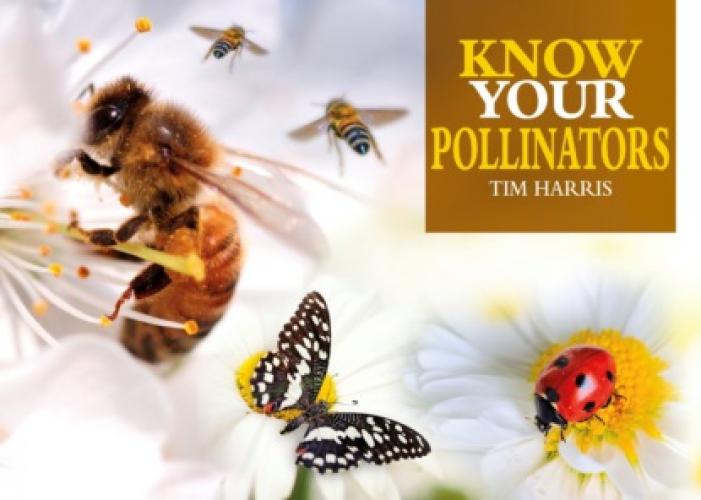4 Western Honeybee
Apis mellifera
Characteristics
Length: Queen 0.70–0.79 in (18–20 mm); worker 0.35–0.39 in (9–10 mm); male 0.47–0.51 in (12–13 mm).
Flight season: Mostly March–October.
Nectar sources: Very varied.
Habitat: Meadows, farmland, woodland, parks, gardens.
Yellowish-buff, with dark bands on the abdomen, this bee probably originated in Africa and was one of the first insects to be domesticated, around 9,000 years ago. Honeybees were taken to North America in 1622 and now live on every continent apart from Antarctica. Most are kept in artificial hives, from which honey and wax combs are harvested. Hives are taken to areas where orchards require pollination.
Unlike most bees, its colonies may persist for several years, and queens can live to eight years of age. If a colony becomes too large, its old queen and many of its workers may “swarm” in spring—leaving the nest en masse to relocate. If this happens, the new queens that emerge fight for dominance.
Colonies may hold up to 80,000 bees, mostly workers that secrete wax to build the hive, clean and guard the nest, raise the young, and forage for nectar and pollen. Workers can communicate the location of good sources of nectar by performing a figure-eight dance. Once the nectar is brought back to the nest, it is converted into honey to feed the colony, and the pollen collected in the workers’ “bee baskets” is used to make “bee bread” to feed the young.
5 Blueberry Digger
Habropoda laboriosa
Characteristics
Length: 0.51–0.63 in (13–16 mm).
Flight season: March–May.
Nectar sources: Blueberries.
Habitat: Swamps, cultivation, gardens.
The North American blueberry digger is only active for a short time each spring. Blueberry cultivation largely depends on this dark bee, which emerges just before the blueberries come into flower. These are solitary, ground-nesting bees. Females dig burrows in loose, sandy soil, and the larvae that emerge from their eggs feed on pollen and nectar left by the mother. They pupate, then emerge the following spring. Newly emerged males are sometimes so keen to find mates that they dig into the ground to find the females before they have emerged!
Although active for just three to five weeks, each female is believed to visit about 50,000 flowers during her short life, pollinating enough of them to produce 6,000 blueberries. The only way pollen can exit the plant’s stamen is from a small opening in the top, and then only when it is shaken. The secret of the blueberry digger’s success is that it latches on to the stamen and rapidly vibrates its flight muscles. This action shakes out the pollen, some of which attaches to the hairy bee and later sticks to the stigma of the next flower visited. Such “buzz pollination” is only practiced by some bees. Bumblebees can also do it, but they don’t emerge until later in the spring.
6 Violet Carpenter Bee
Xylocopa violacea
Characteristics
Length: 0.79–0.87 in (20–22 mm).
Flight season: Late February–June.
Nectar sources: Springblossoming flowers and shrubs, lavender, sweet peas, wisteria.
Habitat: Grassland, scrub, orchards, vineyards, gardens.
This glossy black bee, with a sparse covering of hairs and violet wings, is one of Europe’s largest. The female’s habit of boring into dead wood to create a nest gives this species its name. These bees hibernate over winter and emerge in late winter or early spring to search for mates. After mating, the female looks for a nest site; when she has found some suitable dead wood, she excavates a tunnel in it. Her jaws can burrow in sound as well as rotten wood. She lays between three and thirty eggs in small cells. When the larvae hatch, she places a ball of pollen beside each for them to feed on. The next generation of adults emerges in late summer.
Despite its large size, and the disconcerting buzz of its wings, the violet carpenter bee is not aggressive, and only stings as a last resort. The bee’s liking for wooden pallets as nest sites has helped it colonize new areas in recent years, and it is spreading north in Europe, doubtless helped by climate change.
Конец ознакомительного фрагмента.
Текст предоставлен ООО «ЛитРес».
Прочитайте эту книгу целиком, купив полную легальную версию на ЛитРес.
Безопасно оплатить книгу можно банковской картой Visa, MasterCard, Maestro, со счета мобильного телефона, с платежного терминала, в салоне МТС или Связной, через PayPal, WebMoney, Яндекс.Деньги, QIWI Кошелек, бонусными картами или другим удобным Вам способом.
